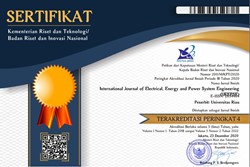The Characteristics of Five Ceramics and Two Granites as Solid Dielectrics for An Ozone Generator
The Characteristics of Five Ceramics and Two Granites as Solid Dielectrics for An Ozone Generator
Abstract
The utilization of ozone is commonly applied in various fields, for instance, it is used as a disinfectant for water treatment, disinfecting, sterilizing medical devices and preserving foodstuffs. Ozone is a nearly colorless gas with a characteristic odor that can be detected by humans up to 0.01 ppm. It can be produced by the dielectric barrier discharge method,which is generally used as a method of generating ozone supplied by high voltage or also called high voltage plasma generators. High voltage plasma occurs in the dielectric barrier discharge air gap, as a result of the air failed in maintaining its insulator properties. The power supply used in this study is a parallel resonant pushpull inverter using a flyback transformer. Furthermore, this study did not use an additional magnetic loudspeaker and used ceramic dielectrics instead. 5 types of ceramics and 2 different types of granite and combined the range of air gap were used during examination and research. The research indicates that the best plasma was found in ceramics 3, 5, granite 1 and 2 with an air gap of 2mm. The current discharge in ceramic 1 with an air gap of 2 mm was higher than the others. The highest voltage discharge was on granite 2 with an air gap of 2 mm. Ceramics 3, 5, granite 1 and 2 with an air gap of 2mm had better ozone concentrations than ceramics 1, 2 and 4.
References
[1] Prihatinningtyas , E, “Ozon Suatu Dilema, Warta Limnologi”, No. 40, Oktober 2006.
[2] Agus Purwadi, Widdi Usada, Suryadi, Isyuniarto, Sri Sukmajaya, 2003. “Konstruksi Pembangkit Ozon Bentuk Silinder dengan Teknik Lucutan senyap” Jurnal Putlisbang Teknologi Maju BATAN, Yogyakarta.
[3] Sosiawati Teke, Muhammad Nur, Tri A Winarni, “Produksi Ozon dalam Reaktor Dielectric Barrier Disscharge Plasma (DBDP) Terkait Panjang Reaktor dan Laju Alir Udara Serta Pemanfaatannya Untuk Menjaga Kualitas Asam Amino Ikan”, Universitas Diponegoro, Semarang, 2014.
[4] F. Murdiya, A. Hamzah and D. Andrio, "The Application of Non-Sinusoidal Resonance Inverter on An Ozone Generator," 2019 IEEE Conference on Energy Conversion (CENCON), Yogyakarta, Indonesia, pp.142-146, doi: 10.1109/CENCON47160.2019.8974757, 2019.
[5] Murdiya, F., Suwitno, Anto, B., Ervianto, E., Hamdani, E., & Amri, A, “Barrier Discharge In Magnetic Field: The Effect Of Magnet Position Induced Discharge In Gap”. 2018 2nd International Conference on Electrical Engineering and Informatics (Icon EEI 2018), Batam-Indonesia, 2018.
[6] Murdiya, Febrizal, Amun Amri, ”The performance of surface barrier discharge in magnetic field driven by half bridge series resonance converter”, Journal of Mechatronics, Electrical Power, and Vehicular Technology, Vol.8, No.2, pp.95-102, 2017.
[7] Peka‘rek, S, “Experimental Study of Pulse Polarity and Magnetic Field on Ozone Production of the Dielectric barrier dischargein Air”, Plasma Chemistry Plasma Processing, Springer, 2018.



















